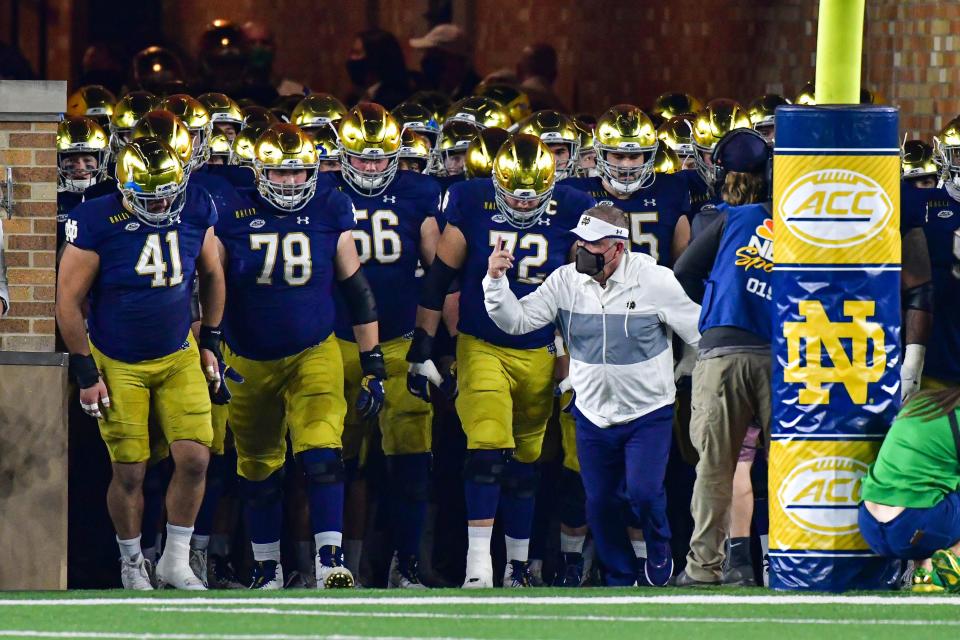Analysis: What's next for the Power 5 conferences after SEC expansion?
With the SEC preparing to add Texas and Oklahoma, attention shifts to the three options at hand for each of the remaining Power Five conferences:
Expand in an attempt to keep pace with the SEC from a competitive and financial perspective, with each move triggering a series of corresponding moves across the entire Football Bowl Subdivision;
Stand pat and batten down the hatches in an effort to prevent other conferences from raiding or poaching teams from its current lineup of members;
Or, in the case of one league in particular, decide whether to remain a conference altogether.
Several factors serve to complicate an already confounding issue.
One is the genuine lack of productive expansion targets outside of current members of Power Five conferences and a small handful of teams playing in the Group of Five. Even in that case, options left behind by the Big 12, for example, simply don't move the needle for the ACC, Big Ten and Pac-12.
Another is the possibility that the SEC isn't done yet, and if so whether there is anything another conference can do to hold down the fort should one of its schools be extended an invitation — especially with the SEC on a path to rake in $1.3 billion in revenue during the 2024-25 fiscal year with the addition of the Longhorns and the Sooners.
The Pac-12 does not believe "expansion is required to continue to compete and thrive," commissioner George Kliavkoff said Tuesday from the conference's media day.
"That said, the fallout from Texas and Oklahoma gives an opportunity to once again consider expansion," he added. "We’ve already had significant inbound interest from other schools. We will work with our chancellors and presidents to evaluate these opportunities.”
For the Pac-12 and others, Kliavkoff's comments get to the heart of the issue: Like it or not, expansion is on the table. Here are the options at hand for each Power Five conference and what could be next for the FBS.
Big 12

The conference is no longer viable as a national contender without Texas and Oklahoma, which has left a roster of eight teams — Baylor, Iowa State, Kansas, Kansas State, Oklahoma State, TCU, Texas Tech and West Virginia — with nearly nonexistent coast-to-coast appeal and a worryingly dire future when it comes to negotiations for the next grants of media rights agreement.
Expansion is the key to the league's long-term survival. But where, who, when? To start with, there's Central Florida, Cincinnati, Houston, SMU and South Florida from the American, which would expand the Big 12's map and might make the league slightly more appealing to potential broadcast partners.
That's if the Big 12 can even entice these teams from the American. These Group of Five programs may have long wanted a seat at the Power Five table, but would this reworked Big 12 really be any more appealing as a permanent destination than the American, especially with a reworked College Football Playoff format providing greater opportunity to teams outside the Power Five umbrella?
But there's an argument for the Big 12 standing pat for the immediate future. With a rights deal signed through 2025 that would be split eight ways with Texas and Oklahoma projected to leave early for the SEC, current Big 12 members are due for increased annual payouts for the next several years. That might be enough to temporarily keep the band together but it doesn't do anything to secure the conference's future in 2026 and beyond.
Big Ten

Kansas and Iowa State are there for the taking, but how do these programs help the Big Ten add revenue and form a competent on-field challenge to the SEC's dominance? Neither provides needed help where it counts: first in dollars and cents, then in wins and losses. (Kansas mainly brings losses to the table.)
To keep pace with the SEC would take bold and decisive moves from a conference that no longer drives the national conversation on the issue of expansion. With no attractive option within the league's existing geographic footprint, the Big Ten's best option — should it decide to expand at all — would be to delve into the Pac-12, either by creating a partnership or by raiding that conference of its best members, beginning with Southern California and Oregon.
The second option would seem so distasteful to Big Ten leadership that it's difficult to imagine, especially given the longstanding ties and relationships between the two leagues rooted in the Rose Bowl.
But it would be the best way to stand up to the SEC given the league's projected 16-team membership and options to expand even further. A conference that adds several current Pac-12 members — let's say the Trojans, Ducks, UCLA, Washington, Utah and Colorado — could draw more eyeballs than the SEC and make a reasonable case for being as nationally relevant in the chase for the national championship.
Pac-12
The Pac-12 is on far, far surer footing than the Big 12. Still, the league faces a similar dilemma: What are the options for expansion? The pickings are slim, especially if the league wishes to remain in its current footprint.
Boise State, Brigham Young and San Diego State are nearby options with flaws, though SDSU has made significant strides in facilities and plays in one of the largest cities in the country.
Current Big 12 members would leap at a lifeline extended by the Pac-12, but why would the conference make such an offer? Oklahoma State, Baylor, Texas Tech and others are strong, proud athletics programs with centuries of combined history at the highest level of college sports. And it doesn't matter one bit. If expansion does continue, these programs may be the biggest names left on the cutting-room floor.
ACC

It's all about Notre Dame for the ACC, which desperately needs to rework its existing rights deals, which run through 2036, and get its annual revenue more in line with the SEC and Big Ten. With the proposed 12-team playoff format built to accommodate Notre Dame's typical schedule, it won't be easy to convince the Fighting Irish to go back on 100 years of independent status. (Last year's pandemic season notwithstanding.)
Obviously, adding Notre Dame improves the league's on-field product while drawing in one of the biggest names in all of sports, college or otherwise. It would also be fantastic if the ACC could add one or more of Alabama, Ohio State, USC and the New York Yankees. Why not dream big?
But you have to ask. Reeling in Notre Dame would allow the ACC to add a 16th team, whether that's West Virginia, Cincinnati or another, and still have the leverage to renegotiate its media deals more in line with the top leagues in the FBS.
And while the duration of the league's existing rights deal would make it complicated — and likely extremely expensive — for any team to leave the ACC, not putting its members on more solid financial footing may be equally costly. Would a sizable buyout really stop the SEC or Big Ten from reaching in and grabbing Clemson, North Carolina and others?
SEC
Why stop at 16 teams? Why not 18, 20, 24, even 32?
The possibilities are endless for the SEC, which is set to seamlessly add two historic powerhouse programs to its roster and has the wherewithal to go even bigger. Expansion is driven by the survival of the richest, and the SEC currently has more money to offer a potential new member than any other league in the FBS.
The conference has several options within driving distance. One is Clemson, the closest thing to a true threat to Alabama's dynasty. Other options include Florida State, Miami and North Carolina. That would push the SEC's roster to 20 teams.
Whether you believe the SEC is finished after bringing in Texas and Oklahoma depends on how much stock you put into Commissioner Greg Sankey's statement on Tuesday, when he said in part, "the SEC has not proactively sought new members."
Even if that's true and the conference had not initiated any conversations to that point, does that wait-and-see approach still hold given the possibility of expansion and realignment across the FBS? The rest of the Power Five would love to know the answer.
Follow colleges reporter Paul Myerberg on Twitter @PaulMyerberg
This article originally appeared on USA TODAY: SEC expansion will force Power 5 conferences to make moves, but what?

